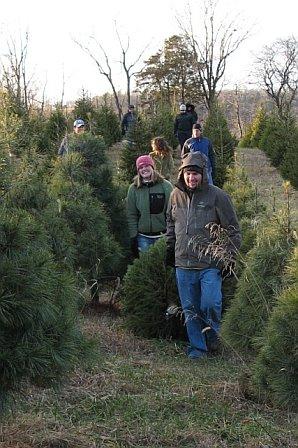Think you know all about Christmas Trees? Read more . . .
 Christmas trees have been sold commercially in the United states since about 1850. Until fairly recently, all Christmas trees came from the forest.
Christmas trees have been sold commercially in the United states since about 1850. Until fairly recently, all Christmas trees came from the forest.- Thirty-four to thirty-six million Christmas trees are produced each year and 95 percent are shipped or sold directly from Christmas tree farms.
- California, Oregon, Michigan, Washington, Wisconsin, Pennsylvania and North Carolina are the top Christmas tree producing states. Oregon is the leading producer of Christmas trees – 8.6 million in 1998.
- The best selling trees are Scotch pine, Douglas fir, Noble fir, Fraser fir, Virginia pine, Balsam fir and white pine.
- More than 2,000 trees are usually planted per acre. On an average 1,000-1,500 of these trees will survive. In the North, maybe, 750 trees will remain.
- Almost all trees require shearing to attain the Christmas tree shape. At six to seven feet, trees are ready for harvest.
- It takes six to ten years of fighting heavy rain, wind, hail and drought to get a mature tree.
- Selling directly to the consumer has become a major market for many Christmas tree farms.
- Some tree farms offer the consumer the chance to select his own tree while it is still growing in the tree farm.
- In the United States, there are more than 21,000 Christmas tree growers.
- In the United States, there are more than 12,000 cut-your-own farms.
- In 1979, the National Christmas Tree was not lighted except for the top ornament? This was done in honor of the American hostages in Iran.
- Between 1887-1933 a fishing schooner called the “Christmas Ship” would tie up at the Clark Street bridge and sell spruce trees from Michigan to Chicagoans.
- Since 1966, the National Christmas Tree Association has given a Christmas tree to the President and first family.
- The first decorated Christmas was in Riga, Latvia in 1510.
- Growing Christmas trees provides a habitat for wildlife.
- Recycled trees have been used to make sand and soil erosion barriers and been placed in ponds for fish shelter.
- The first Christmas tree retail lot in the United States was started in 1851 in New York by Mark Carr.
- Christmas trees take an average of 7-10 years to mature.
- Christmas trees remove dust and pollen from the air.
- Since 1971, the Province of Nova Scotia has presented the Boston Christmas Tree tree to the people of Boston in gratitude for the relief supplies received from the citizens of Boston after a ship exploded in 1917 following a collision in the Halifax, Nova Scotia Harbor. Part of the city was leveled killing and injuring thousands.
- The use of evergreen trees to celebrate the winter season occurred before the birth of Christ.
- Christmas trees are grown in all 50 states including Hawaii and Alaska.
Choosing A Christmas Tree Variety
 Each year there seems to be more varieties to choose from for that perfect Christmas tree. The varieties vary in characteristics, availability and price.
Each year there seems to be more varieties to choose from for that perfect Christmas tree. The varieties vary in characteristics, availability and price.
Fraser firs have been referred to as the “Cadillac of Christmas trees.” The needles are flat, 1/2 to 1 inches, and have a rich, dark green color with a silvery underside. It has excellent color and needle retention characteristics. They tend to be “naturally-shaped” Christmas trees. Although becoming somewhat more prevalent, due to their limited production in this area and their high quality, they may be harder to find and higher priced than other varieties.
For a “full” appearing tree, white pines are often good. They are widely available in the Midwest. It has longer needles at 3 to 6 inches. It has generally good needle color and retention.
The spruces are gaining in popularity, too. The needles tend to have good retention, and are shorter and stiffer than some of the other varieties. The spruce varieties often are popular when buying a live Christmas tree for planting in the yard after the holiday. Remember, live trees do need some special care for successful planting after the holidays.
The traditional favorite Scotch pine has 1 1/2 to 3 inch blue-green needles, which have a somewhat twisted appearance. The branches tend to be more open and stiffer than the white pine. Many people prefer it since it often is easier to hang ornaments on its branches. It is also often one of the most widely available and reasonably priced varieties.
Other varieties are also available at tree lots or from fresh-cut tree farms.
Regardless of the variety of the tree, be sure to properly water the tree and keep it in as moist and cool of a location in the house as possible. Avoid putting it near heat outlets. Be sure to check the water level at least daily. The water should never drop below the bottom of the trunk of the tree. These will help lengthen the tree’s enjoyment and safety.
With all these choices, everyone should be able to find that “perfect tree.” Buyers may want to take a day for a holiday outing to discover the different types of trees available and to make some consumer comparisons. It can be a fun outing, as well as good consumer shopping, to go out and compare the varieties and the costs at various farms and sales lots.
Go here for lots more information on Christmas Trees:
